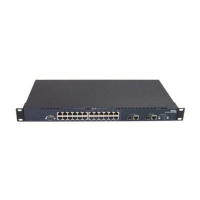BigIron RX Series Configuration Guide 797
53-1002253-01
Filtering
26
If you want to filter for a special character instead of using the special character as described in
Table 26.2 on page 26-45, enter “\” (backslash) in front of the character. For example, to filter on
AS-path strings containing an asterisk, enter the asterisk portion of the regular expression as “\*”.
BigIron RX(config-bgp)# ip as-path access-list acl2 deny \*
To use the backslash as a string character, enter two slashes. For example, to filter on AS-path
strings containing a backslash, enter the backslash portion of the regular expression as “\\”.
BigIron RX(config-bgp)# ip as-path access-list acl2 deny \\
_
An underscore matches on one or more of the following:
• , (comma)
• { (left curly brace)
• } (right curly brace)
• ( (left parenthesis)
• ) (right parenthesis)
• The beginning of the input string
• The end of the input string
• A blank space
For example, the following regular expression matches on “100” but not on
“1002”, “2100”, and so on.
_100_
[ ]
Square brackets enclose a range of single-character patterns. For example, the
following regular expression matches on an AS-path that contains “1”, “2”, “3”,
“4”, or “5”.
[1-5]
You can use the following expression symbols within the brackets. These
symbols are allowed only inside the brackets.
• ^ – The caret matches on any characters except the ones in the brackets. For example,
the following regular expression matches on an AS-path that does not contain “1”, “2”,
“3”, “4”, or “5”.
[^1-5]
• - The hyphen separates the beginning and ending of a range of characters. A match
occurs if any of the characters within the range is present. See the example above.
|
A vertical bar (sometimes called a pipe or a “logical or”) separates two
alternative values or sets of values. The AS-path can match one or the other
value. For example, the following regular expression matches on an AS-path that
contains either “abc” or “defg”.
(abc)|(defg)
NOTE: The parentheses group multiple characters to be treated as one value. See the
following row for more information about parentheses.
( ) Parentheses allow you to create complex expressions. For example, the following complex
expression matches on “abc”, “abcabc”, or “abcabcabcdefg”, but not on “abcdefgdefg”.
((abc)+)|((defg)?)
TABLE 122 BGP4 special characters for regular expressions (Continued)
Character Operation

